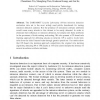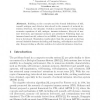101
click to vote
ISSADS
2005
Springer
15 years 6 months ago
2005
Springer
An intrusion detection system (IDS) usually has to analyse Giga-bytes of audit information. In the case of anomaly IDS, the information is used to build a user profile characteris...
93
Voted
IDEAL
2005
Springer
15 years 6 months ago
2005
Springer
Abstract. The work presented in this paper shows the capability of a connectionist model, based on a statistical technique called Exploratory Projection Pursuit (EPP), to identify ...
121
Voted
ICNC
2005
Springer
15 years 6 months ago
2005
Springer
The DARPA/MIT Lincoln Laboratory off-line intrusion detection evaluation data set is the most widely used public benchmark for testing intrusion detection systems. But the presence...
ICCSA
2005
Springer
15 years 6 months ago
2005
Springer
In order to complement the incomplete training audit trails, model generalization is always utilized to infer more unknown knowledge for intrusion detection. Thus, it is important ...
111
Voted
ICCNMC
2005
Springer
15 years 6 months ago
2005
Springer
In this paper, we propose a distributed hierarchical intrusion detection system, for ad hoc wireless networks, based on a power level metric for potential ad hoc hosts, which is us...
87
Voted
ICANN
2005
Springer
15 years 6 months ago
2005
Springer
This research employs unsupervised pattern recognition to approach the thorny issue of detecting anomalous network behavior. It applies a connectionist model to identify user behav...
91
Voted
GECCO
2005
Springer
15 years 6 months ago
2005
Springer
Genetic Programming (GP) based Intrusion Detection Systems (IDS) use connection state network data during their training phase. These connection states are recorded as a set of fe...
112
click to vote
FPL
2005
Springer
15 years 6 months ago
2005
Springer
Software-based Network Intrusion Detection Systems (NIDS) often fail to keep up with high-speed network links. In this paper an FPGA-based pre-filter is presented that reduces th...
101
Voted
CANS
2005
Springer
15 years 6 months ago
2005
Springer
Building on the concepts and the formal definitions of self, nonself, antigen, and detector introduced in the research of network intrusion detection, the dynamic evolution models...
101
click to vote
STORAGESS
2005
ACM
15 years 6 months ago
2005
ACM
In this paper we present a storage based intrusion detection system (IDS) which uses time and space efficient point-intime copy and performs file system integrity checks to detec...






